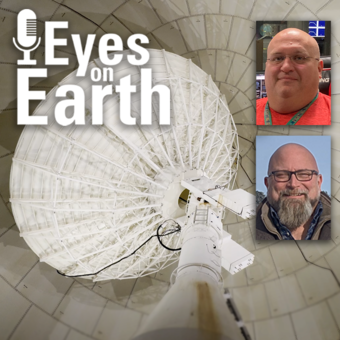Eyes on Earth Episode 129 – What Happens During a Landsat Pass?
For this episode, we go inside the Landsat operations room at EROS to see what happens during a live Landsat pass.

Summary: In this episode, we talk to ground station technicians to find out how Landsat satellite data gets from the spacecraft to EROS and then to the archive. We see what it’s like in EROS’s Landsat operations room and what the technicians do before, during, and after a Landsat pass. The task of making sure those bits of data make their way to the archive so it can be used for land change science occurs for them several times a day. As routine as it might be sometimes, they are a small but important part of a large mission that is documenting global land change.
Guests:
Aaron Hensley (contractor for USGS EROS)
Eric Gaspar (contractor for USGS EROS)
Host: Tom Adamson (contractor for USGS EROS)
Producer: Tom Adamson (contractor for USGS EROS)
Release date: Monday, December 9, 2024
Download and Transcript Access
Related Episodes
-
-
Eyes on Earth Episode 127 – The Historic Landsat 7 Mission
In this episode of Eyes on Earth, we talk about the incredible career of Landsat 7, which collected science imagery of the Earth for nearly 25 years. The Flight Operations Team at NASA Goddard Space Flight Center and engineers at EROS work together to collect imagery, send commands to the satellite, and keep it healthy. After over 133,000 orbits and 3.3 million images collected, Landsat 7 stopped...
-
Eyes on Earth Episode 108 – Landsat 8’s 100th Drag Make-Up Maneuver
The Landsat Program is considered the gold standard for satellite Earth-observation imagery. To keep it that way, the USGS EROS Flight Operations Team continually monitors the flight paths of the Landsat satellites to make sure they stay at a consistent 705-kilometer altitude. That means frequently speeding it up to counter the effects of atmospheric drag. But that’s not all. The team accounts for...
-
Eyes on Earth Episode 81 - Tour of the EROS Radome
The Landsat satellites have been collecting Earth imagery for more than 50 years. A key piece of equipment that moves the data from the spacecraft to the archive so researchers can use it is the antenna at the EROS Center. The antenna and its radome have a fascinating history of their own that adds to the overall Landsat story. In this episode of Eyes on Earth, we go on location to learn about how...
-
For this episode, we go inside the Landsat operations room at EROS to see what happens during a live Landsat pass.

Summary: In this episode, we talk to ground station technicians to find out how Landsat satellite data gets from the spacecraft to EROS and then to the archive. We see what it’s like in EROS’s Landsat operations room and what the technicians do before, during, and after a Landsat pass. The task of making sure those bits of data make their way to the archive so it can be used for land change science occurs for them several times a day. As routine as it might be sometimes, they are a small but important part of a large mission that is documenting global land change.
Guests:
Aaron Hensley (contractor for USGS EROS)
Eric Gaspar (contractor for USGS EROS)
Host: Tom Adamson (contractor for USGS EROS)
Producer: Tom Adamson (contractor for USGS EROS)
Release date: Monday, December 9, 2024
Download and Transcript Access
Related Episodes
-
-
Eyes on Earth Episode 127 – The Historic Landsat 7 Mission
In this episode of Eyes on Earth, we talk about the incredible career of Landsat 7, which collected science imagery of the Earth for nearly 25 years. The Flight Operations Team at NASA Goddard Space Flight Center and engineers at EROS work together to collect imagery, send commands to the satellite, and keep it healthy. After over 133,000 orbits and 3.3 million images collected, Landsat 7 stopped...
-
Eyes on Earth Episode 108 – Landsat 8’s 100th Drag Make-Up Maneuver
The Landsat Program is considered the gold standard for satellite Earth-observation imagery. To keep it that way, the USGS EROS Flight Operations Team continually monitors the flight paths of the Landsat satellites to make sure they stay at a consistent 705-kilometer altitude. That means frequently speeding it up to counter the effects of atmospheric drag. But that’s not all. The team accounts for...
-
Eyes on Earth Episode 81 - Tour of the EROS Radome
The Landsat satellites have been collecting Earth imagery for more than 50 years. A key piece of equipment that moves the data from the spacecraft to the archive so researchers can use it is the antenna at the EROS Center. The antenna and its radome have a fascinating history of their own that adds to the overall Landsat story. In this episode of Eyes on Earth, we go on location to learn about how...
-




